Note: DAN’S 8-STEP APPROACH TO SOLVING ALL SUDOKU PUZZLES
Once you have completed the puzzle, to the extent that you have filled-in all obvious answers and have written all potential options across the top of the unsolved cells (PUZZLE PREPARATION), Dan recommends the following Steps to complete the puzzle.
Step 1: Sudoku Pairs, Triplets and Quads – See September 2015
Step 2: Turbos & Interaction – See October 2015
Step 3: Sudoku Gordonian Rectangles and Polygons – See November 2015
Step 4: XY-Wings & XYZ Wings – See December 2015
Step 5: X-Wings – See January 2016
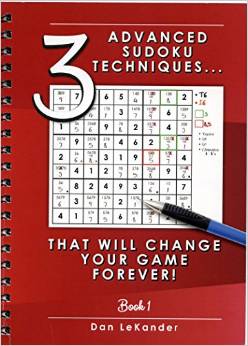
Step 6: DAN’S YES/NO CHALLENGE
Step 7: DAN’S CLOSE RELATIONSHIP CHALLENGE
Step 8: AN EXPANSION OF STEP 7
Steps 1-5 are relatively common techniques and are explained in the TI LIFE articles above. Steps 6-8 are covered in detail, in Dan’s book.
Welcome to February, 2020 with another “impossible” puzzle
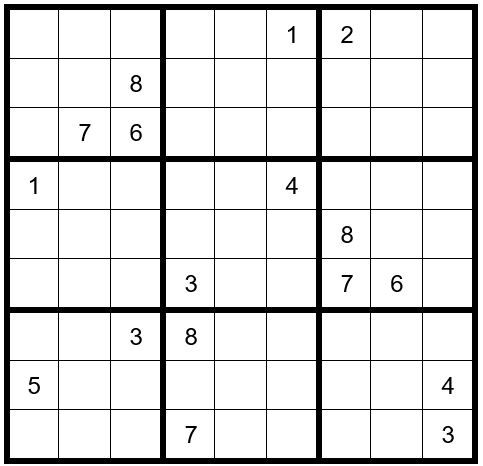
PUZZLE PREPARATION
Prior to utilizing techniques first complete the 5 Steps of Puzzle Preparation …
- FILL IN DATA FROM OBSERVATIONS
- FILL IN OBVIOUS ANSWERS
- FILL IN NOT-SO-OBVIOUS ANSWERS
- MARK UNSOLVED CELLS WITH OPTIONS THAT CANNOT EXIST IN THOSE CELLS
- FILL IN THE OPTIONS FOR THE UNSOLVED CELLS
This month we will again complete all of the first 4 steps in the order we observe them, versus all step 1, then step 2, step 3, and step 4 in order, before we move on to step 5. We will start with the 1’s and navigate through 2’s to 9’s, then repeat the process until we conclude all step 1-4 clues.
The first thing we observe is that C2R2 (cell in column 2, row 2) =1 (obvious answer). Then, C8R5=4. Now your grid should look like Example #63.1 below:
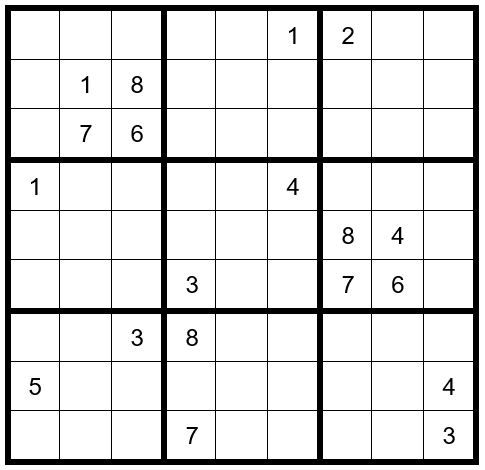
In box 6 a 1 can only exist as an option in C9R5 or C9R6; therefore, a 1 cannot exist as an option in C9R3 or C9R7 (we already know a 1 cannot exist as an option in C9R1 or C9R2). Indi-cate this by placing a small 1 in the bottom of those cells.
In box 1 a 2 can only exist as an option in C1R2 or C1R3; therefore, a 2 cannot exist as an option in C1R5, C1R6, C1R7 or C1R9.
In box 6 a 3 can only exist as an option in C7R4 or C8R4; therefore, a 3 cannot exist as an option in C3R4.
In box 1 a 5 can only exist as an option in C2R1 or C3R1; therefore, a 5 cannot exist in C4R1, C5R1, C8R1 or C9R1.
In box 9 an 8 can only exist as an option in C8R8 or C8R9; therefore, an 8 cannot exist as an option in C8R1 or C8R3.
In box 8 a 4 can only exist as an option in C5R7 or C5R9; therefore, a 4 cannot exist as an option in C5R1, C5R2, or C5R3.
Now your grid should look like Example #63.2 below:
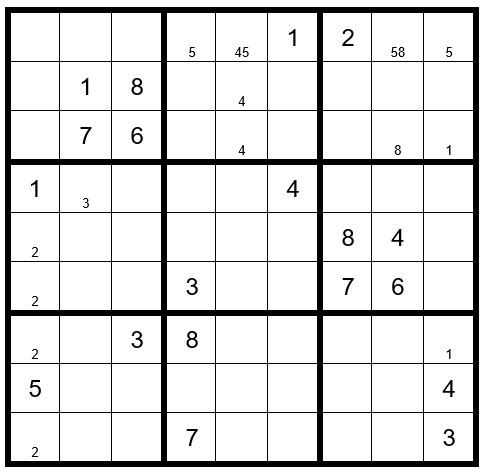
We have now completed Puzzle Preparation steps 1-4, so we will fill-in the options for the un-solved cells. Now your grid should look like Example #63.3 below:
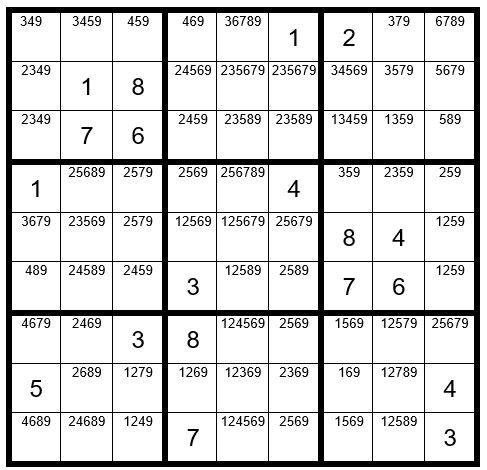
Step 1-5
There are no Step 1-5 clues. We will now proceed to Step 6: Dan’s Yes-No Challenge.
There are 3 circumstances that establish the potential for a Step 6 exercise:
- Look for just 2 unsolved cells in a box that contain the same option where these 2 cells are not in the same row or column.
- Look for just 2 unsolved cells in a column that contain the same option where these 2 cells are not in the same box.
- Look for just 2 unsolved cells in a row that contain the same option where these 2 cells are not in the same box.
We will start by searching the 1’s to see if there is a potential Step 6 clue, and then navigate through the 2-9’s.
In column 1, we find just two unsolved cells with option 7. We will call these two cells our “driver cells” which drive the exercise. One of these two cells must be a 7. We will first start with C1R5 and assume it is the 7, to see what effect it has on the other unsolved cells with option 7. Then, we will assume C1R7 is the 7, to see what effect it has on the other unsolved cells. We will annotate C1R5 with a “Y” for yes, and annotate C1R7 with “y” to indicate yes. Please refer to Example #63.4 below:
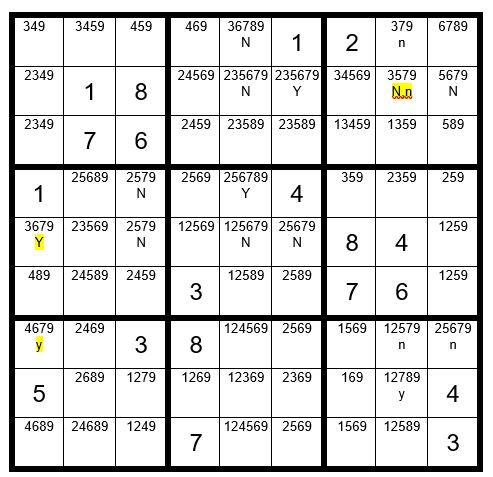
Looking at the example above, if C1R5=7, then C3R4, C3R5, C5R5 & C6R5 are not a 7 (marked as “N”) above. Now C5R4 must be a 7 (Y). It follows that C5R1 & C5R2=N. C6R2=Y. C8R2 & C9R2=N.
If C1R7=7, then C8R7 & C9R7=n. C8R8=y. C8R1 & C8R2=n.
Our conclusion is simple, the cell with the N,n designation is not a 7 regardless of which starter cell is a 7.
Now your grid should look like Example #63.5 below:
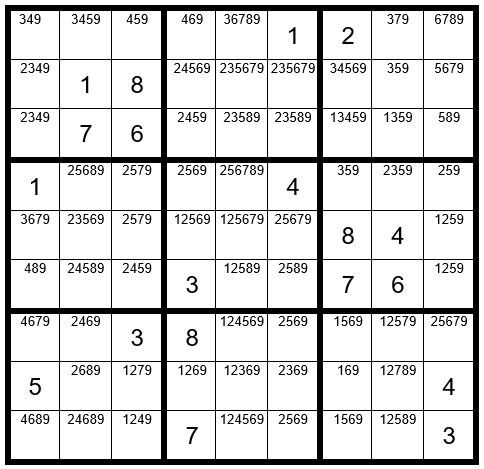
Above is an example of a Step 6 exercise that produced a single result, not creating any other clues.
There are no additional Step 6 exercises that might produce results. There can be no Step 7 or 8 clues, as at least one unsolved cell must have only two options. This will force us to technique that we applied in a previous puzzle: Nishio is a Japanese word for a technique that can be employed on any Sudoku puzzle. It works like this … pick any unsolved cell and then pick one option for that cell and assume the cells has that number as its solution. Then, track the results through the grid to prove that this cell cannot have the chosen number as its solution, thus eliminating that option.
You will find the following results:
• The tracking of the number through the grid is inconclusive. You then move on to another choice. This result happens most of the time.
• The tracking of the number through the grid creates a conflict. Then you know that number is not a correct choice for that cell and you eliminate the option. That discovery may or may not lead to additional Step 1-8 clues.
• The tracking of the number through the grid brings you to a successful conclusion in solving the puzzle. This is a rare occurrence.
The key to this technique is to take some time to pick a cell and option that has a decent chance to track through the puzzle and lead to a conclusion, whether it be a conflict or solves the puzzle.
In this particular puzzle I chose C3R8 with the option 7 for the following reasons: There are only two unsolved cells in box 7 that have a 7 as an option. If we can prove that one of those two cells is not a 7, then the other cell in box 7 must be a 7, giving us a solved cell, which hopefully will produce additional results. We will attempt this in Example #63.6 below, keeping our work in the second level of each cell to preserve the original puzzle in the top level:
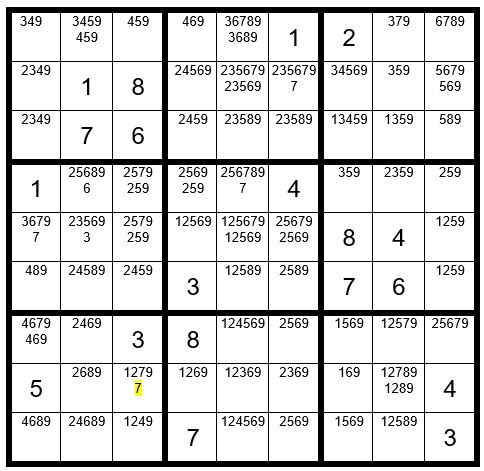
Starting with C3R8=7, we eliminate the 7 as an option in box 7, row 8 and column 3. We then see that C1R5=7. Then C5R4=7. C6R2=2. C2R5=3. C2R4=6. We will pause here and take a look at row 4. What do you observe? There is no possibility of an 8 in row 4! Therefore, we have proven that C3R8 cannot be a 7, and therefore, C1R7=7, giving us Example #63.7:
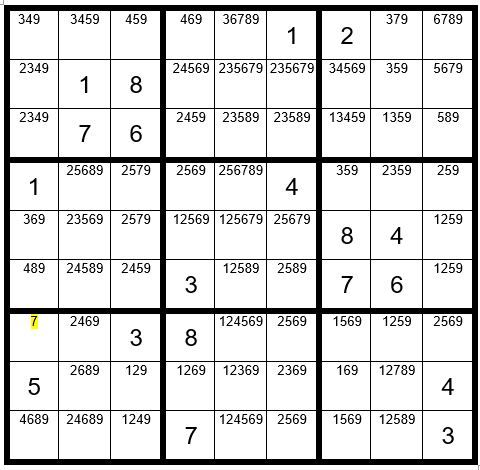
It then follows that C8R8=7, C8R9=8, C2R8=8, C1R6=8 and so forth, leading to an easy solution per Example #63.8 below:
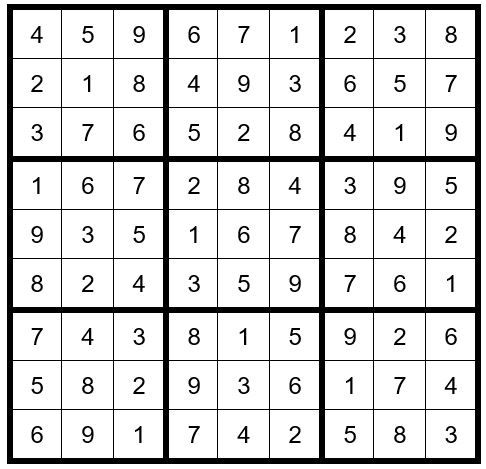
NOTE: In an effort to promote Sudoku and its creative problem-solving benefits, I would enjoy gifting books in bulk to teachers who wish to use the book in their classrooms. Additionally, I would enjoy gifting copies to senior centers and assisted living homes. As I have a limited supply, please respond soon to be included. Please send requests to my e-mail …
djlsuniverse@yahoo.com
May the gentle winds of Sudoku be at your back.
By Dan LeKander
Editor's Note:
First, we thank you Dan, for the generous offer you made above.
Each month I write that it was back in January 2016, when we published a final article in Dan's Series of Steps to learn the logic of Sudoku – that he asked if we would like a puzzle to solve every month … this editor said an enthusiastic… Yes, please! Now we are several years later and on Puzzle #63.
If you have not already done so, I suggest you purchase Dan’s book:
